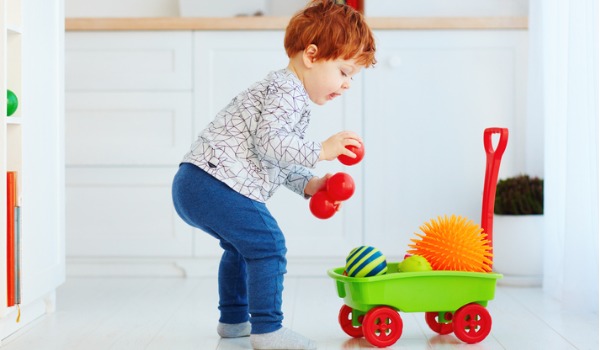If You Take Away Your Child’s Toys Now, Will You Stop Them From Becoming an Addict Later?

Sometimes a throw-away remark lingers in your mind.
‘You know, we didn’t bring any toys, but the kids had a ball. They played together for hours on the beach, without bickering.’
My friend told me when she came back from a family visit to Australia. Her three children were all below seven and looking far too tanned for an Irish winter.
Her words, sandwiched between usual back from holiday chat, stayed with me. And ever since, I have been wondering, do we need so many toys cluttering the house?
No toys, but plenty of imagination
It turns out we don’t, at least not according to the heads of many nurseries in Germany, Austria, and Switzerland.
Every year, they reserve three months for kids aged 3–6 to play without toys, arts and crafts, building blocks, and even books. Nothing remains apart from furniture, a few blankets, pillows, and plenty of space. It seems stark, but the founders of the ‘Spielzeugfreie Kindergarten’ (toy-free nurseries) say it allows children to develop their creativity and social skills when not stifled by toys.
Elisabeth Seifert, the managing director of Aktion Jugendschutz, a Munich-based youth nonprofit that promotes this project, tells the Atlantic.
“In toy-free time, they don’t play with finished toys. They develop their own games. They play more together, so they can better develop psychosocial competencies.”
American research backs up this theory, as it shows that under five’s can’t concentrate when surrounded by too many toys. So much so, they can’t focus on one toy long enough to learn from it.
How does going toy-free prevent addiction in later life?
An addiction study group, Aktion Jugendschutz- set up by public health officers Elke Schubert and Rainer Strick, argues there is an essential need for children to play, and in doing so, taking possession of the world and developing personal skills.
Elke Schubert writes:
Since life skills such as strengthening a person’s communicative capacities or self-confidence need to be promoted from early childhood on, it goes without saying that addiction prevention has to commence at a very early age.
Schubert and Rainer theorized that if adults constantly stimulate children with toys, kids don’t learn to develop coping mechanisms when bored, frustrated, or lonely, as boredom can make them reach for toys instead of developing their imagination.
So when they’re adults, their theory goes, instead of having internal mechanisms to channel frustrations, they rely on external crutches like drugs, alcohol, materialism, or even gambling to escape their suffering.
An easy way to teach children life skills?
However, if we remove the toy or screen-crutch, caregivers almost force children to develop problem-solving competencies like critical thinking, social skills, and creativity. These skills will serve them well later in life when dealing with setbacks.
Also, considering Schubert and Rainer wrote their theory in the nineties, they didn’t include screens in their hypothesis. Still, with 78 % of American homes owning tablets, I think it’s fair to say, for toys read devices.
Critics abound
However, not everyone agrees with this approach. Parents remain divided whether three months is too long, with some worrying their children will get bored.
Also, Hans Mogel, a psychology professor from the University of Passau, says:
This is a form of child abuse. Deprivation comes at the expense of feeling secure and developing a healthy self-esteem.
However, plenty of toy-free social media groups advocate for parents to spend less money on toys but more time reading and playing with their kids instead.
A NOP poll, calculating that there were £5 billion of unused toys in the UK’s homes, makes a strong case for spending wisely in toy shops.
Other benefits of scaling back on toys:
- With 80% of toys ending up in landfills, you’ll reduce waste by not buying any in the first place.
- Less clutter in the house; yes, I can get behind this.
- Save money-spend it on books or experiences instead.
Interested in Marie Kondoing your child’s toy box?
Considering most experts agree around twenty good quality toys are enough for pre-schoolers, here are a few tips for scaling back:
- Before you start: explain to your child why you’re doing this.
- Start small: go toy-free for a day or a weekend and see what happens.
- Try this in the summer, for lots of outdoor opportunities.
- Set a good example by buying less stuff yourself.
- Let your child get bored without directing her.
Final thoughts
Toy-free groups advocate scaling down on toys to stimulate children’s natural creativity and develop problem-solving competencies like critical thinking, social skills, and creativity.
German public Health Officers Schubert and Rainer theorize that if adults constantly stimulate children with toys, kids don’t learn to develop coping mechanisms when bored, frustrated, or lonely. Growing up, this can lead them to use external crutches like drugs, alcohol, materialism, or even gambling to deal with inner pain.
While some may find going toy-free akin to child abuse, scaling down might work better for the average caregiver. Decluttering also means less waste, more money in your pocket, and less plastic in your home-something I will happily try.
So, have a go at taming your toys, help the planet and watch your child thrive in a clutter-free house.
—
Previously Published on Medium
The post If You Take Away Your Child’s Toys Now, Will You Stop Them From Becoming an Addict Later? appeared first on The Good Men Project.
